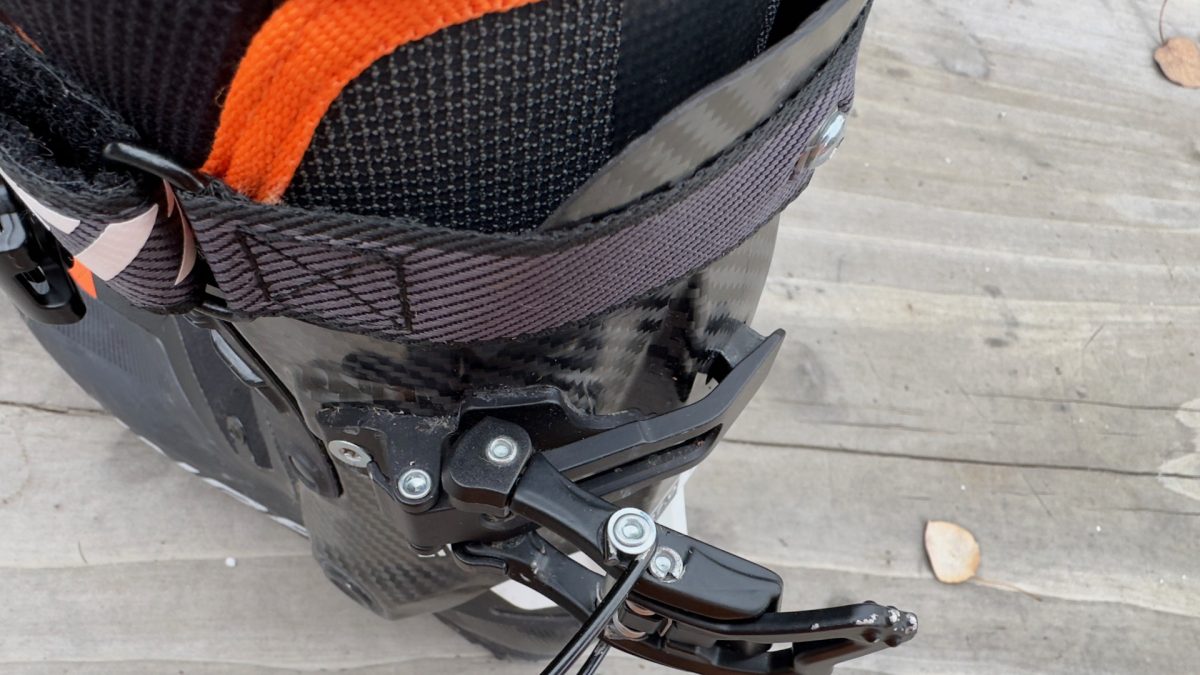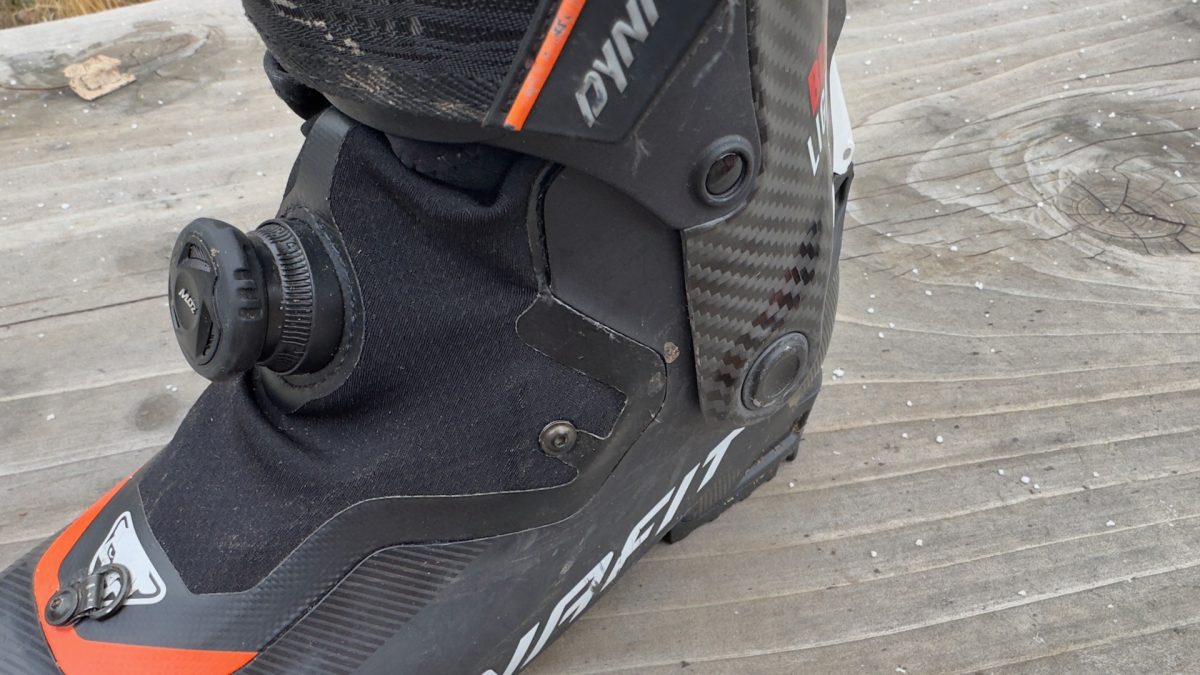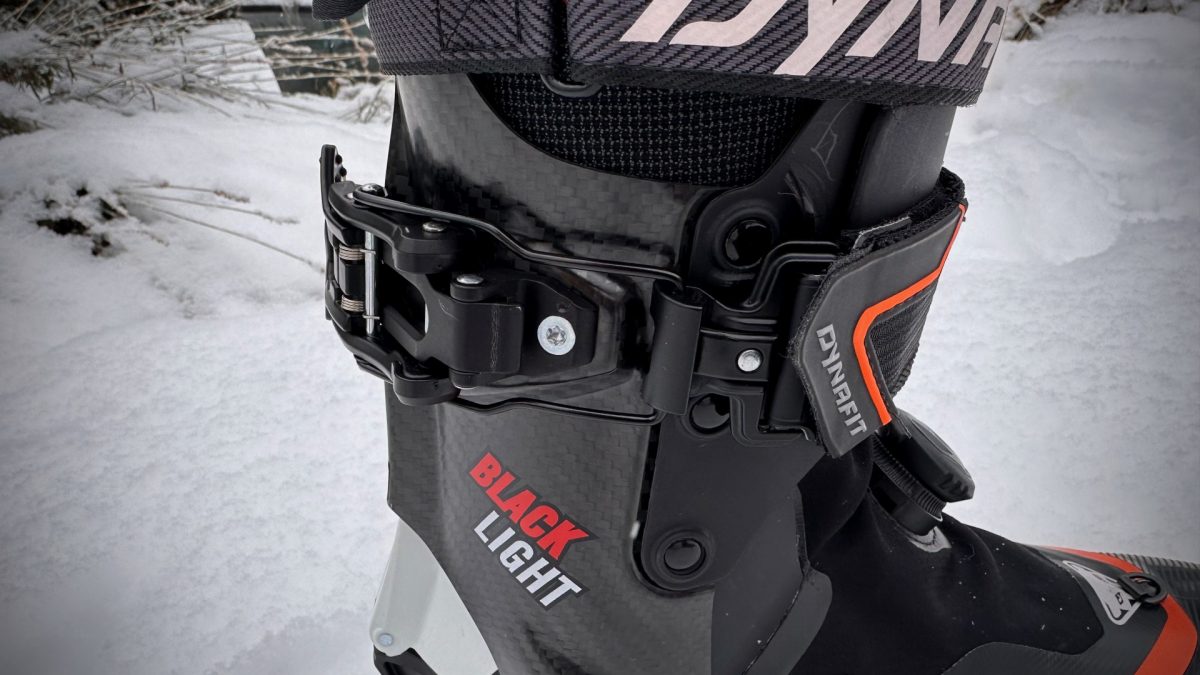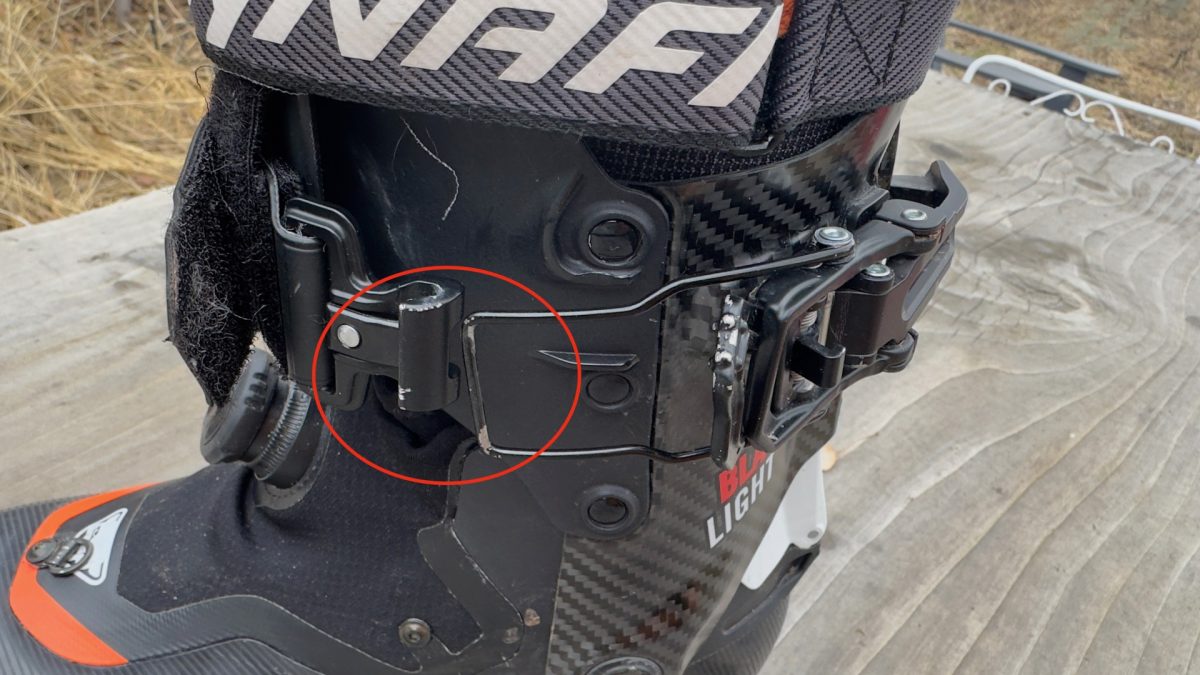The glossy carbon weave is attractive. When carbon is employed, we pay a premium for lightness and stiffness: Dynafit’s Blacklight ski boot doubles up with real-world stiffness and is a high-functioning boot for any mountain mission.
Practically speaking, there is no other way to test and review a boot than jumping right into it with the walking, scrambling, cramponing, skinning, and skiing.
Dynafit markets the Blacklight as a speed touring boot: and it is that. What that means is this is not a freeriding boot (read high cuff, meh range of motion, and four buckles) but a worthy boot you’d wear on long missions to drive a ski in the 95mm width range and under. In short, it is a stiff boot, built on an almost identical chassis and liner system to the softer yet capable Dynafit TLT X. Our Blacklight first look spent some time discerning the differences in flex between the two models.
Not just for Skiing: the Walkabout
I’m hoping where you live, you can access a trailhead for touring without walking much this time of year. Slapping skins on skis from the start is ideal. For this time of year, mid-February, I’ve rambled enough in the Dynafit Blacklights to know they are up to the task of step after step after step up a trail to snowline. The claimed range of motion is ~60 degrees. Know that the liner build and friction experienced when walking is walk-friendly. My time heading into ski with @cascadeconnections on the west flank of Mt. Jefferson ground truthed this. Like the TLT X, if you are looking for a spring skiing boot for missions with significant approaches, intermittent climbing, or scrambling, you’ll be in good hands (feet?) with this boot.
Oregon’s snow year, at least from the catalog of images posted on social media and elsewhere, has not been as deep or photogenic as other mountain ranges. Locally, the high pressure and warming temps have made for some firm skiing and firm approaches that are not so typical this time of year. But the best skiing is where you find it, which most of the time is close to home.

To note here, as the buckle arm is unclasped, the buckle and ultra lock system can rotate slightly and ease from walk to “almost” ski mode. I experienced this several times while using crampons.
Cramponing up firm snow and surfaces coming close to an approximation of ice is a breeze in the Blacklight. There is, however, one thing to watch for. The main powerstrap is a time-tested system that incorporates a buckle throw to secure the boot’s upper cuff and switch the boot in and out of ski/walk mode. What makes the throw system work is a hook fixed to the powerstrap side (see photo) that locks/clasps the buckle arm.
While cramponing, I loosen the power strap and secondary mini-powerstrap to ensure a maximum range of motion and minimal friction. I did notice several times while ascending when the boot suddenly experienced a limited range of motion. An unforeseen change underfoot when in crampons cab be unsettling. This all caught my attention.
In these instances, I found the buckle arm had unhooked from the power strap’s clasp. This allowed the ski/walk mechanism to nudge into ski mode. The accidental near lock-out only happened on the left boot and was remedied by tensioning the main power strap’s velcro and reconnecting the buckle arm to the clasp. In the future, when using crampons, I’ll position the main power strap’s velcro a bit tighter than I might otherwise to prevent this.
I know the debate between buckles and BOA (and BOA-related systems) rages on. Let it rage. I can comfortably snug the forefoot to eliminate heel lift and still be comfortable walking and skinning in this boot for hours. Read that as no blisters or discomfort from rubbing. This includes no discomfort after fully dunking my left boot in Mill Creek after I slipped off an icy rock. The Blacklight passed the 5k of soaking wet sock and liner skinning test.
One last comment on skinning/walking in this boot relates to fit and blister prevention. There was some back-and-forth after the first look relating to heel fit. Let’s assume we have some general similarities about our heels and some differences too. I’d say the heel fit skews to those with slightly wider heels (and I mean slightly). I don’t get discernible heel lift when skinning or walking in the Blacklights. But as one does with a boot lower, one can gently tighten the boot lower to secure the forefoot and mitigate heel lift in walk mode.
I know the debate between buckles and BOA (and BOA-related systems) rages on. Let it rage. I can comfortably snug the forefoot to eliminate heel lift and still be comfortable walking and skinning in this boot for hours. Read that as no blisters or discomfort from rubbing. This includes no discomfort after fully dunking my left boot in Mill Creek after I slipped off an icy rock. The Blacklight passed the 5k of soaking wet sock and liner skinning test.

The lower shell of the Blacklight features a Twistfit closure that is similar to a BOA closure. Internally, as you tighten the Twistfit, a cable is tightened that secures a semi-rigid plastic fitting over the forefoot. This is an effective and secure retention system.
We uphill here at WildSnow. Meaning that roughly 90 percent of the day, you’re not using an anti-gravity assist machine; you are going uphill using your own power. Which, to most of us, is part of the attraction. But so, too, is the descent.
Last winter, when inquiring about the Dynafit Blacklight, I asked someone who had been in many boots what they thought. And their general feedback was the Blacklight was not much stiffer than the TLT X, which features a fiberglass-infused plastic cuff.
My experience does not align with this at all. The Blacklight’s carbon cuff (which is beautifully crafted) makes this a stiff skiing speed touring boot. Stiffer than the TLT X? For me, that’s a hard yes.
I’ve used the Blacklight and the TLT X in the full spectrum of conditions. And in softer snow, I kept returning to the question of who needs a boot this stiff for driving a ski I’d want to use with this boot. Again, I prefer a boot in the 1kg class of boots to drive skinnier and lighter skis. (In the lightest of powder, I might bump this boot up to use with a bigger and wider ski.)
At 5’10” and 160 pounds and vacillating between aggressive skiing and cruisy turns, I could easily find my flex sweet spot with the softer TLT X. But, on this recent Mt. Jefferson mission, I did find myself in some steep, firm, exposed, and frankly unnerving snow.
The Blacklight’s carbon-induced stiffness was very much to my liking. And further down the face when the snow softened a bit, making for most excellent soft-landing jump turns, I knew then why the extra stiffness was desired: the Blacklights are precise and predictable. (The stiff skiing Blizzard Zero G 95s underfoot were a perfect ski pairing too.)

The Dynafit Blacklight illustrates a well engineered interface between the Grilamid lower shell and carbon cuff. What you can expect is great tourability and excellent stiffness while descending.
Who is this Boot For?
The simple answer to the above prompt is this: this boot is for those looking for a light and stiff boot. The carbon cuff does translate into real-world stiffness. The Blacklight is not as progressive flexing as the TLT X, nor is it a brick wall. With the type of power I employ to push and carve a lighter and shorter ski, I’m certainly in the middle of desiring a softer flex like the TLT X and a stiffer boot like the Blacklight.
I’ve had the good fortune of trying different boots in diverse mountain settings. In isolation, either boot, the TLT X or the Blacklight, could work great for me. I used the TLT X on a big traverse last spring and loved it. But tasting the sweet stiffness of the Blacklight’s carbon cuff in higher consequence terrain will have me reach for this boot more frequently in the spring, particularly when the sharp and pointy tools are present for the ascent, as I might be finding firm terrain on the descent.
One thing I’d change, and this is a very small detail, I like the option of running a lace on my liners: lace eyelets would be nice, but that’s being picky.
Back to the question of who this boot is for. If choosing between a TLT X and this boot (let’s assume you have narrowed down the fit to these boots), the Blacklight is flat-out stiffer. The boot lowers differ slightly. The Blacklight has a carbon-infused Grilamid lower compared to the TLT X’s straight-up Grilamid. I do not experience more torsional stiffness in the Blacklight’s lower than the TLT X. When you lean forward and transfer energy to your skis, that’s where you’ll notice the difference.
Let’s answer the question, though. For super-aggressive skiers, you will likely over-flex the TLT X, which you can experience with a simple carpet test. You know who you are. The Blacklight will have your back.
The Blacklight Stats
Weight: Blacklight 27.0/27.5 shell w/27.0 liner stock footbed + optional mini-powerstrap: 1118g. For comparison, weight TLT X 27.0/27.5 shell w/27.0 liner stock footbed + optional mini-powerstrap: 1118g
Optional mini-power strap weight: 19g
Lower shell construction: Carbon-infused grilamid
Cuff: Carbon fiber
Boot spoiler: The white on the boot’s rear — Grilamid
Forward Lean: adjustable 15° or 18°
Sole: Pomoca
Liner: Dynafitter 5 (so far, no heat molding necessary)
Price: $899.95
Shop for the Dynafit Blacklight Boot.
Jason Albert comes to WildSnow from Bend, Oregon. After growing up on the East Coast, he migrated from Montana to Colorado and settled in Oregon. Simple pleasures are quiet and long days touring. His gray hair might stem from his first Grand Traverse in 2000 when rented leather boots and 210cm skis were not the speed weapons he had hoped for. Jason survived the transition from free-heel kool-aid drinker to faster and lighter (think AT), and safer, are better.


